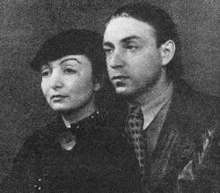Margit Anna
| Margit Anna | |
|---|---|
 Margit Anna (left) with her painter husband Imre Ámos in the 1930s | |
| Born |
Margit Sichermann 23 December 1913 Borota, Austria-Hungary |
| Died |
3 June 1991 (aged 77) Budapest, Hungary |
| Nationality | Hungarian |
| Known for | Painting |
| Spouse(s) | Imre Ámos (19??-1944/1945; his death) |
Margit Anna (born Margit Sichermann; 23 December 1913 – 3 June 1991) was a twentieth century Hungarian painter[1].
She attended Vaszary's school from 1932–36, and traveled to Paris with her husband, Imre Ámos, also a painter, in 1937. There they met Chagall and his influence can be seen in her early work. Her early period was similar to Imre Ámos's art with lyric presentation with grotesque elements which characterize her paintings. Following the death of her husband in a Nazi concentration camp in 1944 or 1945,[1] her style became harsher and more elemental and from 1945–48, a new motif appeared in her pictures of puppets symbolizing man exposed to history.
After 1949, she could not take part in art life for a long time but she began to paint again in the mid-1960s. Her pictures symbolized suppressed tragedy such as Pleasure Ride, (1967), and innocence Tale (1964) with surreal and expressive metamorphoses of the puppet motif. She died on 3 June 1991, aged 77.
Works
References
- 1 2 Turai, Hedvig. "Margit Anna". Archives of Women Research and Exhibitions. Retrieved 15 July 2017.